Brick in the kitchen: from finishing to creating a kitchen set
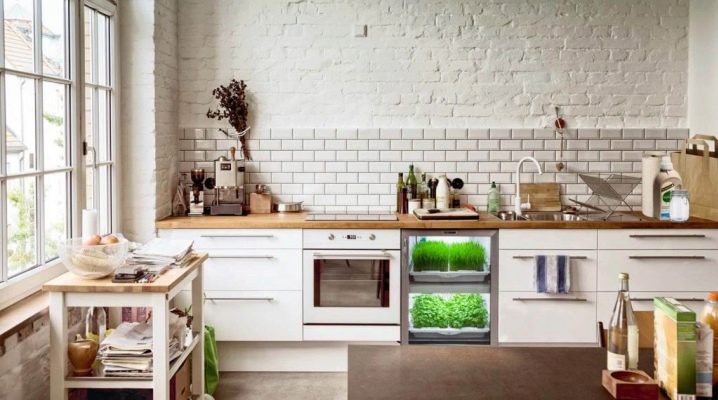
Brick in the interior has long and firmly entered our life. At first, it was used exclusively in the direction of the loft in the form of brickwork. Then they began to use it in Provence style, in Scandinavian and in all country versions. Gradually, brick elements moved to other directions: techno, modern, eclecticism, minimalism. And today, brick can be used in many kitchen interiors, if it is dosed and administered correctly.

A bit of history
The fashion for brick in the interior appeared in the 40s of the last century in America. When the rent for land within the city rose sharply, and industrialists began to move their production to the outskirts, the empty workshops were occupied by artists for their workshops and students, who could not afford to pay for ordinary housing. Then, in spacious rooms, restaurants and exhibition halls were located, they pushed the weird industrial loft style into fashion... The bohemian part of the population realized the benefits of the huge abandoned premises actually in the center of the city. The rebuilt workshops and warehouses became expensive elite housing and drove poor artists and students out of their territories.
In the 60s of the last century, the industrial style firmly entered Europe. In our country, it began to gain momentum at the turn of the 20th and 21st centuries.




In the interior
Brick is used in any kitchen, but not every room can withstand its abundance. In a large brick room, you can lay out anything from walls to furniture, and in a small one, this material should be introduced in small portions.
In the interior of the kitchen, one, two or all walls are made of stone. In the room, the floor and the working apron look brutal made of brick. Stone columns and arches look good. Nicely in harmony with the rest of the industrial-style interior, a niche for a stove or an exhaust zone, lined with bricks.





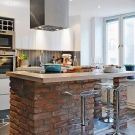
Brick structures are often left in their natural state, but sometimes they are painted, plastered, covered with ceramics or tiles.



If a decision is made to introduce brick finishing into the interior, some design subtleties should be taken into account.
- In a small kitchen even a thin finishing brick will steal extra centimeters. The solution can be a "native" brick wall, free of plaster, moreover, painted white.
- Large kitchens can afford any stone. Dark red and gray bricks will not significantly affect the volume of a spacious room.
- Brick - porous material, and before covering the kitchen, you should treat it with water-repellent impregnations, otherwise it will lose its attractive appearance over time.
- Considering the weight of the material, it is better to work in the interior with a hollow or facing stone.
- Kitchen partially equipped with brickslooks better made entirely of this material.
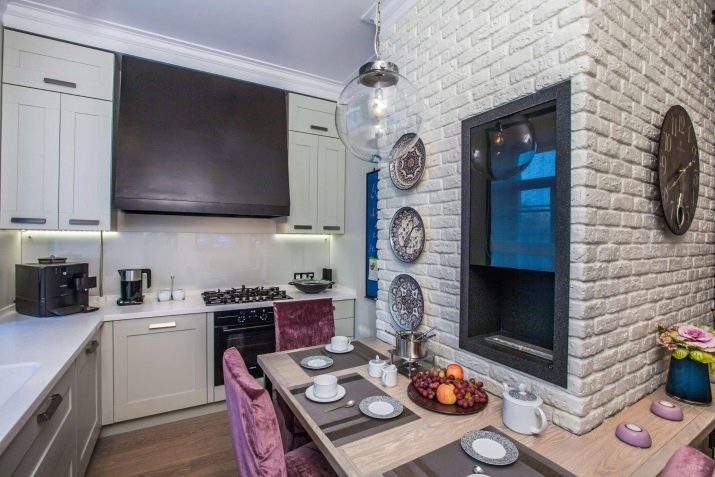


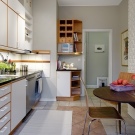


Brick buildings also have their drawbacks.
- They are heavy and not every kitchen can be loaded with them.
- Stone furniture, niches, masonry and so on take a long time to build and leave a lot of dust and debris behind.
- It is necessary not to make a mistake in the calculations at the project stage, otherwise you can create problems with communications or wiring.
- Brick furniture cannot be changed. It is actually eternal and will get bored before it collapses.
- Selling an apartment with stone furniture is not easy; it can be mistaken for an unauthorized change in the housing project.




Types of brickwork
There are different ways in which brick design is introduced into the interior of the kitchen. Let's consider each of them.
Stationary house wall
This method is suitable for brick houses, they make it possible to use the material laid down during the construction and absorbed the energy of the house. You just need to free the brick wall from the finish. Of course, the process is laborious, you have to put up with dust and construction waste, but you can get a "native" wall without external finishing materials. This masonry has its positive aspects:
- looks natural;
- durable;
- environmentally friendly;
- allows the walls to "breathe";
- combined with many finishing materials;
- to make such a masonry, a specialist is not needed; it is quite possible to clean the wall yourself.



The original look of the wall attracts attention and I don't want to write about the disadvantages of such a design, but they are:
- a wall with an uneven structure absorbs fat and other manifestations of kitchen life well, and it is difficult to care for it;
- the material absorbs moisture well, which will also require additional care;
- building bricks do not reflect light, they often have dark shades, which visually reduces the space of the kitchen.
Paint and varnish coatings will help to correct the situation, which will make the wall lighter, making it much easier to care for it. Correctly distributed lighting will create the effect of volumetric space. In very small kitchens, you can use a fragment of a stone wall.



Brick wallpaper
For interiors that do not require mandatory reliability, photowall-paper made under a brick is suitable. Modern printing capabilities allow them to be made as close as possible to the original, the catch can be noticed only upon closer examination of the material. This technique is endowed with sufficient advantages:
- good quality, visually has a great similarity to brickwork;
- washable wallpaper is easy to clean;
- a large selection of textures and colors, matched to any interior;
- glue the wallpaper - the work is dust-free, you can do it yourself.
The disadvantages include a synthetic base of washable wallpaper, in which the wall does not breathe. It is irrational to use natural paper rolls in the kitchen, they will quickly become unusable.



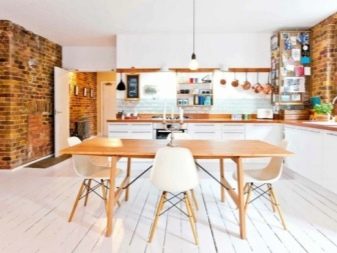
You can apply varnish on natural types of wallpaper, thereby extending their durability, or use glass. Those who are not burdened with environmental ideas can take advantage of the washable options.
Brick tile
Some items look very authentic. The walls are faced with clinker, ceramic or concrete tiles. They can have a glossy, matte surface or a torn brick texture. The pluses of kitchen tiles include:
- beautiful appearance, has a great similarity to the original;
- environmental friendliness;
- rich selection of products;
- easy to clean;
- does not absorb moisture.



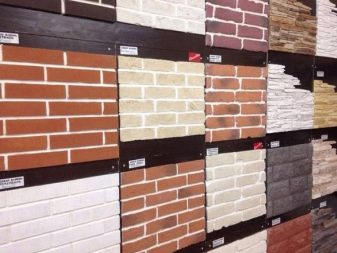
The tiles also have disadvantages:
- the tile is a weak thermal and sound insulator;
- it is not easy to hang shelves on it;
- it is more difficult to mount than to paste wallpaper;
- it costs more than wallpaper.


Gypsum brick
For some design interiors, plaster bricks are made by hand, then they are painted in the desired color.
The work is painstaking, but such laying has many advantages:
- the interior is beautiful;
- provides environmental focus (the wall breathes);
- you can choose any color;
- the material is durable, easy to process;
- excellent sound and thermal insulation;
- imitation of the type of brick and thickness completely depends on the taste of the owner;
- gypsum masonry in white visually expands the space.




The disadvantages include the properties of gypsum to absorb steam and moisture. Varnishes for finished masonry or special mineral additives at the manufacturing stage will help to increase moisture resistance.
Combined cladding
Already knowing about the different properties of the material, the finishing in the kitchen can be combined.For the wall near the stove and sink, it is better to choose tiles, where it is necessary to hang shelves, wallpaper with a brick pattern is suitable, a free wall can be made of plaster or from "native" masonry. Sometimes natural brick is used, with its help partitions are installed in a studio apartment, some elements of furniture. In this case, the weight of the material must be taken into account.
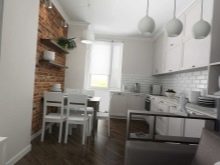
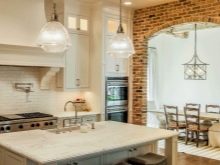

Furniture
Building a brick kitchen seems like an incredible undertaking. But there are situations when such interiors are justified. In large cold houses, where dampness is a frequent visitor, chipboard furniture swells and deteriorates. And the brick is reliable, kind, eternal, will never let you down. Such furniture looks solid and beautiful.
The base for the lower tier of the pedestals is made of brick, because of the weight of the material, the upper tier is not made of stone. The countertop is poured with concrete, cutting a slab and a sink into it, and the door facades are made of wood.
White silicate brick looks great in combination with dark wood species. And if you paint the wood black and use red clinker stone, you can get the effect of an old kitchen.



A large room is divided into zones with brickwork or a bar counter made of the same material. The dining table can also have a brick base and a stone top. In this design, it will look respectable, even if an artificial stone is used for the coating.



Beautiful examples
Today, many are introducing beautiful, environmentally friendly bricks into the interiors of their kitchens. Examples can be used to see how such rooms look.
- Using a brickwork wall in a country style.

- Kitchen set made of white brick with wooden facades.

- The interior has brick floors and walls, an unusual layout of a work apron.

- Dining table with brick base.


- Several types of bricks are used in the kitchen. This technique made it possible to play in contrast with the furniture and leave the room with a light, light tonality.
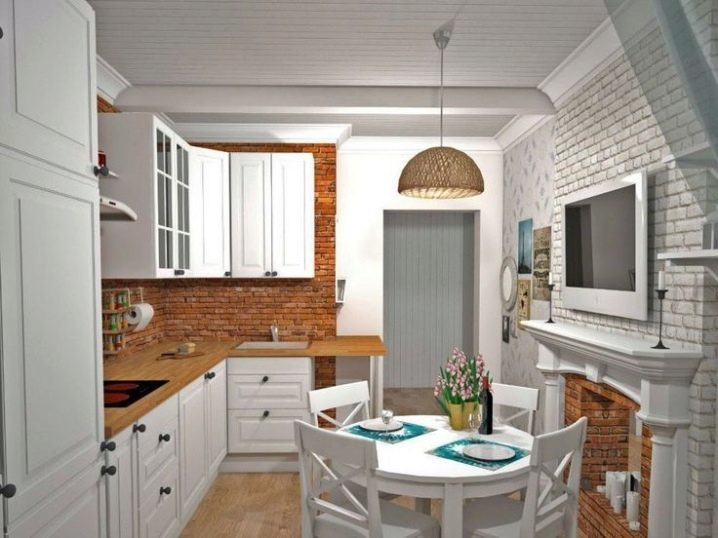
- The kitchen is made in high-tech or loft style using brick and metal.

- An example of using bricks in a small room.

- Fragmented brickwork in a Parisian kitchen.

Using bricks in the interior means following age-old traditions. It can add weight and solidity to the ambiance of a rich and respectable kitchen.
For decorative brick in the kitchen, see the next video.













The comment was sent successfully.